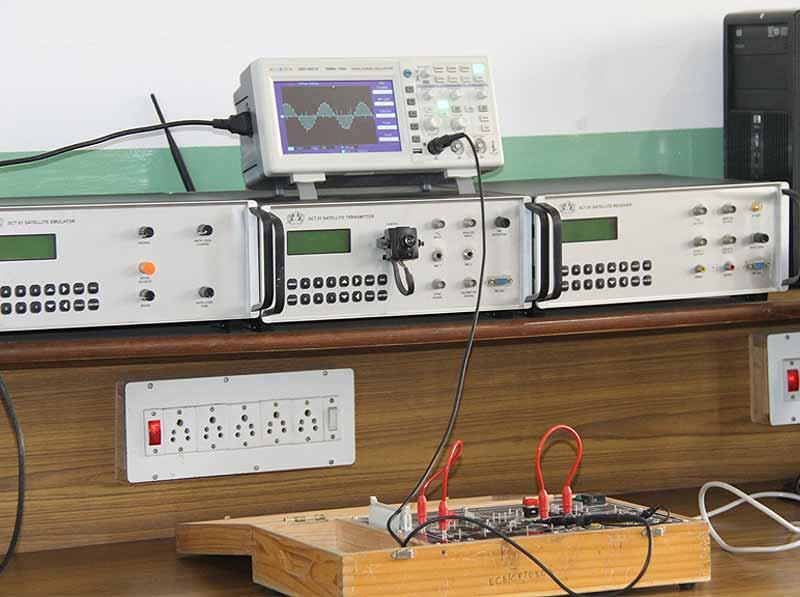Derive a mathematical expression for the average real power deliver by a single phase a.c. source with an e.m.f of \(e=\sqrt{2}E_m\sin\omega t\) when the source current is \(i=\sqrt{2}I_m\sin\left(\omega t-\theta\right)\). Define power factor of an a.c. circuit. State the major disadvantage of poor power factor.
\(e=\sqrt2E_m\sin{\omega t}\) … (1)
\(i=\sqrt2I_m\sin{(\omega t-\theta)}\) …(2)
The instantaneous power p is thus given by
\(P=ei=2E_mI_m\sin{\omega t}\sin{(\omega t-\theta)}\)
\(P=E_mI_m[\cos{\left(\omega t-\omega t+\theta\right)}-\cos{\left(\omega t+\omega t-\theta\right)}]\)
\(P=E_mI_m\cos{\theta}-\ E_mI_m\cos{\left(2\omega t-\theta\right)}\) …(3)
The second term in the right hand side of equation (3) contains a double frequency term and it is evident that the magnitude of the average value of this term is zero since the average of a sinusoidal quantity of double frequency over a complete cycle is zero. Thus the instantaneous power consists only the term \(E_mI_m\cos{\theta}\) which is the average power in the passive circuit.
The average power in the passive circuit is given by
\(P_{av}=E_mI_m\cos{\theta}\)
\(P_{av}=2\times\frac{E_m}{\sqrt2}\times\frac{I_m}{\sqrt2}\cos{\theta}\)
\(P_{av}=2\times E\times I\cos{\theta}\)
If the voltage source \(v=V_m\sin{\theta}\), then
\(P_{av}=2\times V\times I\cos{\theta}\)
In purely resistive circuit \(\theta=0\), since e.m.f and current are in same phase. Thus the average power in a.c. circuit having a pure resistance is
\(P_R=EIcos\ 0^0=EI\ watts\)
Let us consider a instantaneous voltage and current sources are \(v=V_m\sin{\omega t}\) and \(i=I_m\sin{(\omega t-\phi)}\). The phase difference between the voltage and current at any instant is represented by \(\phi\).
We know that the instantaneous power
\(P=\frac{1}{2}V_mI_m\cos{\phi}-\frac{1}{2}V_mI_m\cos{(\omega t-\phi)}\)
Thus the average power \(P_{av}=VI\cos{\phi}\)
The term \(\cos{\phi}\) is called power factor. It is the cosine of the angle between the voltage and current in any a.c. circuit. The Power Factor (p.f) is unity in resistive circuit.
Power factor \(\cos{\phi}=\frac{R}{Z}\)
\(\cos{\phi}=\frac{P}{S}=\frac{VI\cos{\phi}}{VI}(=\frac{Watt}{VA})\)
| Load | Power Factor |
| R | Unity \((\cos{\phi}=1)\) |
| L | Zero lag \((\cos{\phi}=\cos{-{90}^0=0})\) |
| C | Zero lead \((\cos{\phi}=\cos{+{90}^0=0})\) |
| R-L | Lagging \((\cos{\phi})\) |
| R-C | Leading \((\cos{\phi})\) |
Power factor (P.F)
\(\cos{\phi}=\frac{active\ power\ P\ (in\ watts)}{apparent\ power\ S\ (in\ volt-amperes)}\)
It is called factor because \(\cos{\phi}\), multiplied with apparent power, S gives the active power as result. The significance of power factor is felt in the thermal generating station for the fuel requirement or in the hydroelectric station for determining the size of turbine and water requirement. The power factor should be as high as possible for such electrical equipment. The range of values of power factor is 0 to 1.
Determine the value R in Fig. 15(a) such that 4 Ω resistor consumes maximum power.
1.png) Fig. 15(a)
Fig. 15(a)

What is meant by entropy of a source?

Write short notes on:

State Channel capacity theorem